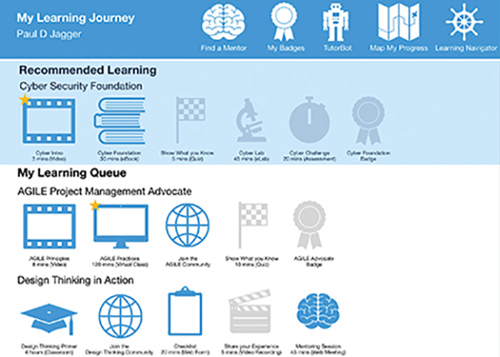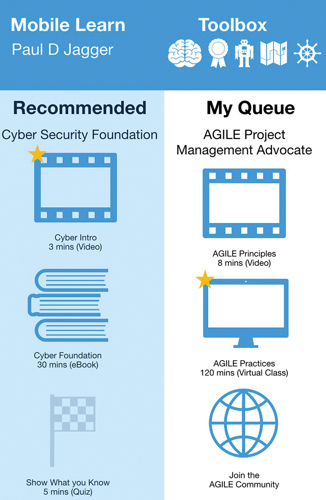Digital transformation is reaching into our professional and personal lives, blurring the line between them, disrupting business models and changing the way we communicate, bank, shop, work, relax and learn. While digital transformation brings many benefits such as access to services on the move, or end-to-end supply chain tracking from purchase to delivery, it also risks creating a society divided along lines of those who know and those who know not.
Those with the knowledge and skills to interact with and shape the digital world will be far better placed to reap its benefits. Conversely, those who lack the knowledge and skills required to navigate the digital world will find their economic opportunities are restricted. Digital transformation is both a skills challenge and a way to close the skills gap.
Business challenges
Two business challenges are of particular relevance to workplace learning and development (L&D) as it pertains to information technology:
- The growth of digital commerce has resulted in many high-profile data breaches, such is the visible impact of the threats posed and actions taken by people intent on stealing information. On the other hand, the demand for cyber security skills has reached a point where the UK has only three applicants for every cyber security job vacancy (Source: Parliamentary report, 2018). It’s expected that, by 2022, there will be 350,000 unfilled cyber security jobs (Source: Indeed, 2018). That is a talent gap in our national cyber defence twice as large as HM Armed Forces. The cyber security skills gap has created an opportunity for commercial L&D providers to provide learning programmes that increase the supply of skilled workers into well paid, stimulating jobs.
- The ubiquitous consumption of digital content through platforms such as YouTube, Netflix and Amazon Prime has raised consumer’s expectations about the speed, ease and pervasiveness of access to media on any device. Social platforms such as LinkedIn and Google+ have enabled collaboration across communities unbound by timezone and location. Learners are also consumers and they bring their expectations of the digital realm into the workplace. This creates opportunities for companies to deliver learning through digital channels in ways that learners are ready to engage with, and actively seek, outside of the classroom or virtual classroom context.
For the commercial learning provider, and the organisation’s L&D function, these opportunities are best grasped in combination rather than isolation. So how can workplace L&D lead the way to capture the opportunities presented by digital transformation of the learning experience and the demand for talent created by the cyber security skills gap?
The consumer is king, not content
The learner should be at the centre of everything L&D delivers, including through digital channels. Specifically, the learner’s digital experience should be:
- personalised - designed for the needs of the individual, reflecting their goals and aspirations;
- customised - adopting the branding, look and feel, house style and cultural convention of the learner’s organisation;
- engaging - in a way that draws the learner in and retains their attention, creating a sense of fun and achievement;
- available on the move - from any device with an internet connection;
- social / collaborative - fostering communities and knowledge sharing;
- bite-sized - just what the learner needs, when they need it, with the ability to consume in chunks;
- accessible - designed for the human condition (not just for those with disabilities);
- integrated - one coherent experience across all trusted sources of learning.
The digital transformation that is sweeping through our economy is only beginning to touch on the way that knowledge is transferred, skills are developed and behaviour is changed in the workplace.
Many large enterprises are struggling with the clunky legacy of the learning management system, a technology that is heavily skewed toward the management of learning, with little consideration given to the learner’s experience. In an era when Netflix, Amazon, YouTube and Google are masters of digital experience, most corporate learning platforms are still pumping out uninspiring page turner compliance and regulatory eLearning; but there is a better way.
Inside the digital experience
Let us imagine a learner’s experience which captures the ease of access, simplicity of navigation, and ubiquity across platforms that Netflix offers to the domestic viewer. Combine that with the cognitive AI capabilities of Google, machine learning chatbots, the user-created content capabilities of YouTube and the storefront digital marketing experience of Amazon. Add to that social / collaborative capabilities of digital community tools and gamification techniques such as scoring, leaderboards and digital badging.
Here is a mock-up of such a personalised digital platform for learning.
Desktop version:

Mobile version:

In this example, cyber security is an identified high-demand skill, hence the Cyber Security Foundation programme promoted to learners as ‘recommended learning’. This learning programme comprises a short introductory video (starred because it has been ranked by peers), an eBook, a check your knowledge quiz, a practical lab session and an assessment. Successful completion of this programme results in the award of an open digital badge that may be displayed in LinkedIn, About.Me or other social platforms.
The learner has also personalised their dashboard with programmes of their own choice (AGILE and Design Thinking), which include other learning activities such as virtual classroom sessions, mentoring sessions, and learner curated content (e.g., a video blog). The learner can check their progress against learning goals and the progress of their peers through a learning journey map.
The digital platform for learning integrates AI technology to enable intelligent search through a learning navigator that makes suggestions, recommendations and highlights learning based upon searches by the learner, their peers and other persons in a similar job role or function. A cognitive chatbot provides online learner assistance 24x7 and mentoring with experts can be arranged through the platform.
The digital learning platform may be deployed either header-less - seamlessly integrated into a client’s learning portal - or adopting the client’s own branding, layout and terminology.
The user interface is responsive to the device on which it is delivered and capable of adjustment to the audio, visual, auditory, cognitive and motor requirements of those with permanent, temporary or situational accessibility needs.
Behind the scenes learning analytics links with business data to show the impact of investment in learning on organisational performance.
I predict the era of the corporate learning-catalogue centric LMS is at an end, and the era of the cognitive, digital learning platform will transform the learner’s experience in both the workplace and among commercial L&D providers.
Diagram credits: Paul Jagger












